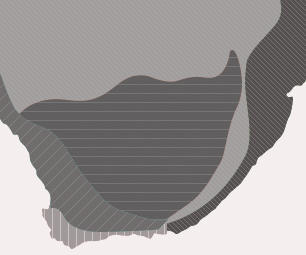Rhigiophyllum squarrosum
Rhigiophyllum squarrosum Hochst.
Family: Campanulaceae
Common names: none recorded
Introduction
Rhigiophyllum squarrosum with its tubular flowers and egg-shaped leaves is a unique member of the South African bell flower family from the southern Overberg.

Description
Description
Rhigiophyllum squarrosum is a rigid, sparsely branched shrub, ± 0.3 — 0. 45 m tall. Its broadly ovate, leathery leaves are overlapping, and in four ranks. Lanceolate bract-like leaves subtend the azure-violet flowers, which are aggregated in a terminal head. The corolla is elongated and consists of a long narrow tube terminated by five spreading lobes. Five epipetalous (borne on the petals) stamens are attached below the apex of the corolla tube but the filaments extend downwards nearly to the base. The style is filiform, exserted, and terminates into three short stigmatic lobes.

There are free carpel-like structures within the inferior ovary, each of which has two to several pendulous ovules attached near the top. Some ovules appear to abort before maturity, leaving just one seed per structure. The capsule opens by means of a plug which comprises the upper part of the ovary and the style, surrounded by the persistent corolla. The line of dehiscence is above the calyx lobes, and the seeds (within seed pockets) are dispersed through a narrow hole.

Flowering is from November to January.
Conservation Status
Status
The species is listed as Vunerable (Raimondo et al. 2009) and is known from about 10 localities. It is under threat from invasive alien plants and habitat loss because of agriculture.
Distribution and habitat
Distribution description
Rhigiophyllum squarrosum is endemic to South Africa on nutrient-poor soils associated with sandstone slopes and is only known from the south-western Western Cape where it occurs from Akkedisberg, north-east of Stanford, to Napier and Bredasdorp.
Derivation of name and historical aspects
History
Hochstetter (1842) established the genus Rhigiophyllum for the sole species R. squarrosum, which was first collected near Elim, Bredasdorp. The name Rhigiophyllum is derived from the Greek rhigios meaning stiff, and phyllon, a leaf, a reference to the plant's rigid leaves.
Ecology
Ecology
Three ecological aspects relating to the seed, pollination and pollen shape of Rhigiophyllum squarrosum are worth mentioning:
- The walls of the carpel-like structures shrink to enclose the seed at maturity, forming a carunculated pocket which is released entire from the mature capsule.
- The oval seeds of R. squarrosum have a strong electrostatic charge and ‘jump' to about 10 cm when manually extracted from the pockets.
- The function of the seed pocket is unknown, but it may perform a role in dispersal, for example by ants.
From the similarity of its floral morphology with that of other fynbos plants, we can infer that this species has a highly specialized pollination syndrome, probably with long-proboscid flies (including horse flies, tangle-wing flies and bee flies) as the principal pollen vectors. Until further studies are completed, we do not know what adaptive advantages, if any, are conferred by the unique triangular pollen. It has however allowed us to recognise the distinctness of the genera Rhigiophyllum and Siphocodon and to place them in a separate tribe, the Rhigiophylleae Eddie & Cupido.
Uses
Use
No economic or cultural uses are recorded for Rhigiophyllum squarrosum.
This species is attractive and potentially a desirable garden plant. However, as with many fynbos plants, the propagation and cultivation could present a challenge.

References
- Eddie, W.M.M., C upido, C.N., & S kvarla, J.J. 2010. Pollen and reproductive morphology of Rhigiophyllym and Siphocodon (Campanulaceae): two unique genera of the fynbos vegetation of South Africa. Bothalia 40: 103 - 115.
- Hochstetter, C.F.F. 1842. Nova genera plantarum Africae. Flora 25: 225 - 240.
- Leistner, O.A. (ed.). 2000. Seed plants of southern Africa: families and genera. Strelitzia 10. National Botanical Institute, Pretoria.
- Raimondo, D., Von Staden, L., Foden, W., Victor, J.E., Helme, N.A., Turner, R.C., Kamundi, D.A. & Manyama, P.A. (eds) 2009. Red List of South African plants 2009. Strelitzia 25. South African National Biodiversity Institute, Pretoria.
Credits
Christopher N. Cupido
Compton Herbarium
January 2012
Plant Attributes:
Plant Type: Shrub
SA Distribution: Western Cape
Soil type: Loam
Flowering season: Early Summer
PH: Neutral
Flower colour: Blue, Purple
Aspect: Full Sun
Gardening skill: Challenging
Special Features:
Horticultural zones







Rate this article
Article well written and informative
Rate this plant
Is this an interesting plant?
Login to add your Comment
Back to topNot registered yet? Click here to register.